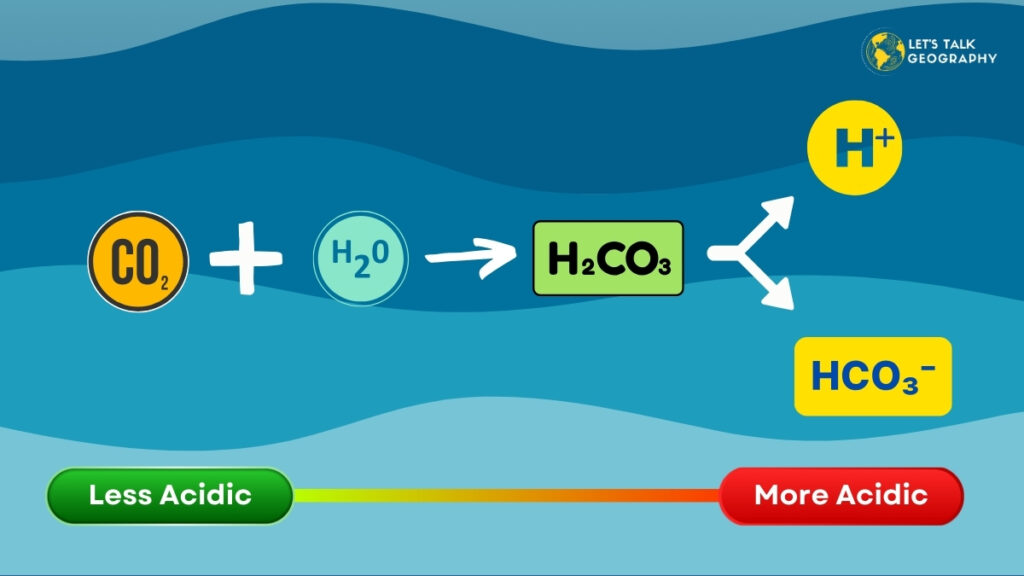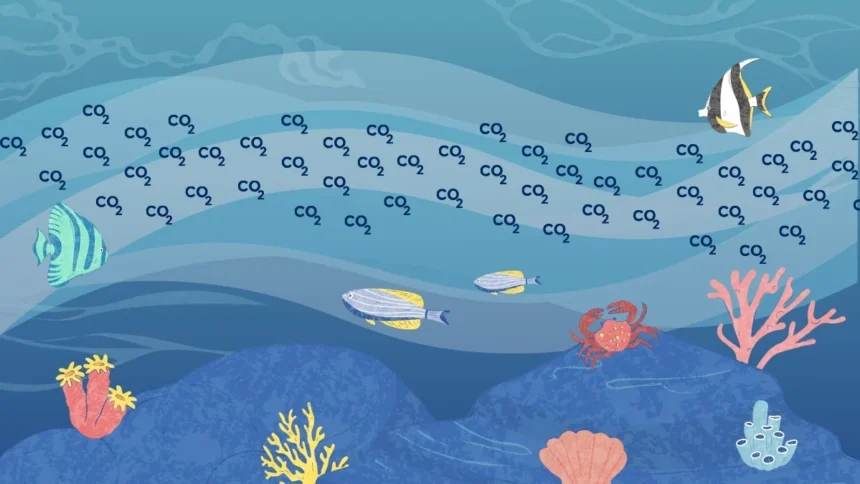Introduction:
Imagine a world where the oceans, the lifeblood of our planet, turn into a hostile environment for marine life. This alarming reality is unfolding due to a phenomenon known as ocean acidification. This process is driven primarily by absorbing excess carbon dioxide from the atmosphere, significantly altering the chemistry of our seas. This change in pH levels is detrimental to marine ecosystems, particularly shell-forming organisms like corals and mollusks.
As the acidification continues, the ripple effects extend to the global economy, fisheries, and coastal communities that rely heavily on the health of the oceans. Understanding ocean acidification is crucial for developing strategies to mitigate its impacts and protect marine biodiversity. This article delves deeper into the causes, effects, and potential solutions for this acidification, highlighting its significance and urging immediate action to safeguard our oceans for future generations.
What is Ocean Acidification?
Ocean acidification is a long-term reduction in the Ocean’s pH, mainly due to the sea absorbing carbon dioxide (CO2) from the atmosphere.
Exploring the Ocean’s acidity, which could have been daunting in the past, scientists were aware of the rise in carbon dioxide levels triggered by the Industrial Revolution in the 1800s.

Causes of Ocean Acidification:
1. Carbon Dioxide Emissions:
The increasing temperature due to the concentration of carbon dioxide in the atmosphere increases ocean surface temperature, resulting in acidification. Although warming and acidification are not very similar situations, they interact to determine the marine ecosystem.
2. Other Contributing Factors:
Deforestation can also lead to ocean acidification because the more trees are cut down, burnt, and left to rot, the more carbon utilized in creating the organic tissues is released as carbon dioxide.
Read: Why is the Red Sea called the ‘Red Sea’?
Chemical Processes Involved in Ocean Acidification:
● Carbon Dioxide Absorption by Oceans:
The Ocean takes carbon dioxide from the atmosphere, particularly when air meets water. Wind makes waves and turbulence, giving the water more chance to grasp the carbon dioxide. Very frequently, fish and other animals in the Ocean take in oxygen and give out carbon dioxide (CO2), similar to land animals.
● Formation of Carbonic Acid:
Carbon dioxide is mainly in the atmosphere and dissolves into seawater. Water and carbon dioxide mix to form carbonic acid (H2CO3), a weak acid that cracks into hydrogen and bicarbonate ions (HCO3). Carbon dioxide is rising, and the reason is human-driven causes.
● Decrease in pH Levels:
Ocean acidification has increased rapidly, leading to a 30% drop in pH since the post-industrial period. Further, the pH level was targeted to be lower than 05 in 2021. It is targeted for the forthcoming days. Seawater pH has lowered from 8.11 in 1985 to 8.05 in 2021. As of 2023-2024, the mean surface water pH is 8.05, lower than the industrial level of 8.2.
Impacts on Marine Life:
● Effects of Ocean Acidification on Shell-forming Organisms:
Corals depend on calcium carbonate to form their skeletons. Still, ocean acidification decreases the carbonate ions, making it more daunting for corals to build and maintain their skeletons and thus forming weaker coral structures. Acidification of the ocean water can also affect corals’ growth rate and reproductive health, disturbing the coral population.
Read: Coral Reef Food Webs: A Fascinating Guide to the Ocean’s Ecosystem
Mollusks, including oysters, clams, and snails, rely on calcium carbonate for their shells. Acidified water decreases the state of saturation of the calcium carbonate, thus making costly shells thinner and weaker shells. Adult mollusks might experience lower growth rates and increased effects of diseases.
Planktonic algae are the major producers of calcium carbonate in the oceans. Thus, acidification decreases their ability to produce and maintain calcium carbonate plates, changing their role in carbon cycling. Acidification of the ocean water even leads to thinner shells and lower buoyancy. Alterations in the plankton populations adversely affect the food web, especially for species that depend mainly on plankton.
● Impact on Fish Species:
Ocean acidification harms fish by affecting their sensory and behavioral abilities and ability to avoid navigation. It even negatively impacts the calcium carbonate-dependent process and impairs the formation of shells for some species. In addition, acidified water can change reproductive success and growth rates, particularly leading to a decrease in population and changes in the marine ecosystem.
● Disruption of Marine Ecosystems:
Ocean acidification can change the marine ecosystem by destroying weak calcifying organisms, including corals and shellfish. This results in habitat loss and declining biodiversity. It also affects the physiological functions of different species of marine animals and changes the food webs and operations of predator-prey relations.
Economic and Social Consequences of Ocean Acidification:
● Impact on Fisheries:
Many shellfish, including clamps and oysters, depend on calcium carbonate. Still, acidification makes access to calcium carbonate difficult, resulting in lower harvests and economic benefits for the fishing industry. Acidification even negatively affects fish’s sensory ability, reducing their populations.
● Tourism and Recreational Activities:
Acidification, in addition to warming waters, bleaches coral reefs. Coral reefs are essential for tourism, thus attracting millions of visitors yearly. Degrading coral reefs has resulted in a decline in tourism revenue, affecting the region’s economy. Coral reefs and other marine ecosystems also assist in protecting natural coasts. Degradation of these reefs leads to increased vulnerability, resulting in coastal erosion.
Read More: Coral Reefs on Death Row: The Coastal Devastation to Come
Global Efforts to Mitigate Ocean Acidification:
- The global efforts that are being put into reducing carbon emissions include the reduction of carbon dioxide (CO2) emissions, the main reason for ocean acidification.
- International agreements, including the Paris Agreement, aim to lower global warming and reduce greenhouse emissions.
- Organizations like the Intergovernmental Panel on Climatic Changes provide scientific assessments to help policy decisions.
- In addition, the Global Ocean Acidification Observing Network tracks changes and their effects on marine life.
- Public and social awareness campaigns must be created to encourage sustainable practices and support the policy.
Read More: Examples of Coral Bleaching in 2024: A Global Crisis
Future Outlook and Predictions:
The future outlook for ocean acidification relies on the emission of global CO2. If the recent rate of emissions continues, the Ocean’s acidity will increase by 100-150% in the coming days, negatively impacting ocean biodiversity.
Some species, including shellfish and corals, would change the marine food web. If the emissions are reduced, then the rate of acidification could be slowed down, but it would require more time to adapt. For that advance, technology utilization and constant monitoring are crucial for changing the Ocean’s acidification routine.
Conclusion:
In conclusion, ocean acidification presents a significant and growing threat to marine ecosystems, driven primarily by the absorption of excess atmospheric carbon dioxide. This process, which lowers the pH levels of ocean waters, severely impacts shell-forming organisms such as corals and mollusks, thereby disrupting the delicate balance of marine life. The economic repercussions are equally profound, affecting fisheries and coastal communities that depend on the ocean’s health.
Understanding ocean acidification is crucial for developing effective mitigation strategies. As we strive to protect marine biodiversity, addressing the root causes and implementing global and local initiatives to reduce carbon emissions is essential. By creating awareness and promoting research, we can put our hard work towards a sustainable future for our oceans. The fight against ocean acidification is a pivotal part of safeguarding our planet’s most vital resource and ensuring the well-being of future generations.
Call to Action for Further Research and Mitigation Efforts:
Join the fight against ocean acidification! Educate yourself and others about this critical issue, support policies that reduce carbon emissions, and engage in sustainable practices. We can safeguard our oceans and ensure a healthy planet for future generations. Start today by sharing this article and reducing your carbon footprint.
FAQs:
What causes ocean acidification?
Ocean acidification is primarily caused by atmospheric carbon dioxide (CO2) absorption. When CO2 levels increase due to human activities such as burning fossil fuels and deforestation, the oceans absorb a significant portion of this excess CO2.
How does ocean acidification affect marine life?
Ocean acidification negatively impacts marine life, particularly organisms that rely on calcium carbonate for making shells and skeletons, such as corals, mollusks, and some plankton species. The increased acidity reduces the access to carbonate ions, making it difficult for these organisms to build and maintain their structures.
Can ocean acidification be reversed?
Reversing ocean acidification is challenging because it requires significant reductions in CO2 emissions. While reducing emissions can slow the process, the existing CO2 already absorbed by the oceans will continue to affect acidity levels for centuries. Mitigation strategies include reducing carbon footprints, implementing renewable energy sources, and enhancing natural carbon sinks like forests and wetlands.
What are the economic impacts of ocean acidification?
Ocean acidification has substantial economic impacts, particularly on industries dependent on marine resources. Fisheries and aquaculture are at risk, as many commercially important species are affected by changes in ocean chemistry. Coral reefs, which support tourism and coastal protection, also suffer, leading to economic losses for communities reliant on these ecosystems. The decline in marine biodiversity can disrupt food security and livelihoods, particularly in coastal regions.
How can individuals help mitigate ocean acidification?
Individuals can help mitigate ocean acidification by reducing their carbon footprint. This can be gained by using energy-efficient appliances, reducing car travel, supporting renewable energy initiatives, and minimizing waste. Additionally, individuals can advocate for policies to reduce carbon emissions, support conservation efforts, and participate in local environmental initiatives. Educating others about ocean acidification and its impacts can drive collective action toward a more sustainable future.
What role do international agreements play in addressing ocean acidification?
International agreements are crucial in addressing ocean acidification by setting global targets for reducing carbon emissions and promoting sustainable practices. Agreements such as the Paris Agreement aim to limit the rise of global temperature, which indirectly helps mitigate ocean acidification. Cooperation among nations can lead to implementing policies and initiatives that reduce CO2 emissions, protect marine environments, and support ocean acidification research and monitoring. Effective international cooperation is essential for tackling this global issue.
References:
- US Department of Commerce, & National Oceanic. (2012). What is ocean acidification? https://oceanservice.noaa.gov/facts/acidification.html
- What causes ocean acidification? (n.d.). Nhm.ac.uk. Retrieved June 5, 2024, from https://www.nhm.ac.uk/discover/quick-questions/what-causes-ocean-acidification.html
- CO2 and ocean acidification: Causes, impacts, solutions. (n.d.). Union of Concerned Scientists. Retrieved June 5, 2024, from https://www.ucsusa.org/resources/co2-and-ocean-acidification
- No title. (n.d.-b). Nasa.gov. Retrieved June 5, 2024, from https://climatekids.nasa.gov/review/ocean/co2-sink.html
- Ocean acidification. (n.d.). Noaa.gov. Retrieved June 5, 2024, from https://www.noaa.gov/education/resource-collections/ocean-coasts/ocean-acidification
- Effects of ocean acidification on corals. (2021, November 15). Oceana USA; Oceana. https://usa.oceana.org/effects-ocean-acidification-corals/
- Marine-conservation.org. Retrieved June 5, 2024, from https://marine-conservation.org/archive/mcbi/OA_factsheet.pdf





